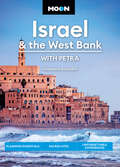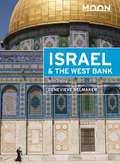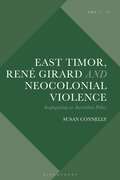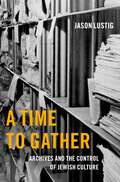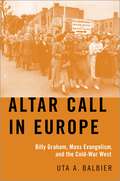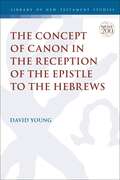- Table View
- List View
Moon Israel & the West Bank: Planning Essentials, Sacred Sites, Unforgettable Experiences (Travel Guide)
by Genevieve BelmakerAncient stories meet modern cities in this deeply significant region where the past is always present. Take the trip of a lifetime with Moon Israel & the West Bank. Inside you'll find:Flexible, strategic itineraries including a week in Jerusalem, three days in Tel Aviv, and a month exploring the region plus excursions to the West Bank, the Dead Sea, and Petra The top sights and unique experiences: Visit the Church of the Holy Sepulchre or pay respects at the Western Wall, and stop at holy sites throughout Northern Israel and the West Bank. Feast on falafel, hummus, and shaksuka and haggle for antiques at a market in Jerusalem. Bike through Tel Aviv's charming Neve Tzedek neighborhood or relax at one of its beaches. Float in the Dead Sea, watch the sun set over the massive Negev craters, or stay overnight in a Bedouin tent encampment Local insight: Journalist and longtime Jerusalem resident Genevieve Belmaker shares the history and culture of her beloved former home Full-color, vibrant photos throughoutDetailed maps for exploring on your own, and useful tips on border crossings and checkpoints Thorough background information on the landscape, history, government, and culture Handy tools and planning essentials including Hebrew and Arabic phrasebooks, health and safety tips, customs and conduct, and information for LGBTQ, female, and senior travelers, families with children, travelers of color, and travelers with disabilities Focused coverage of Jerusalem, Tel Aviv, Haifa, the North Coast, the Galilee and the Golan Heights, the West Bank, Eilat and the Negev, and Petra, Jordan Experience the best of Israel and the West Bank with Moon's practical advice and insider tips. Exploring further? Check out Moon Egypt.About Moon Travel Guides: Moon was founded in 1973 to empower independent, active, and conscious travel. We prioritize local businesses, outdoor recreation, and traveling strategically and sustainably. Moon Travel Guides are written by local, expert authors with great stories to tell—and they can't wait to share their favorite places with you. For more inspiration, follow @moonguides on social media.
Moon Israel & the West Bank: With Petra (Travel Guide)
by Genevieve BelmakerAncient stories meet modern cities in this deeply significant region where the past is always present. Take the trip of a lifetime with Moon Israel & the West Bank. Inside you'll find:Flexible itineraries including a week in Jerusalem, 3 days in Tel Aviv, and a month exploring the region plus excursions to the West Bank, the Dead Sea, and PetraStrategic advice for foodies, pilgrims, beachgoers, archaeology buffs, and moreThe top sights and unique experiences: Visit the Church of the Holy Sepulchre or pay respects at the Western Wall, and stop at holy sites throughout Northern Israel and the West Bank. Feast on falafel, hummus, and shaksuka and haggle for antiques at a market in Jerusalem. Bike through Tel Aviv's charming Neve Tzedek neighborhood or relax at one of its beaches. Float in the Dead Sea, watch the sun set over the massive Negev craters, or stay overnight in a Bedouin tent encampmentLocal insight: Jerusalem journalist Genevieve Belmaker shares the history and culture of her beloved home Full-color, vibrant photos throughoutDetailed maps for exploring on your own, and useful tips on border crossings and checkpointsThorough background information on the landscape, history, government, and cultureHandy tools including Hebrew and Arabic phrasebooks, health and safety tips, customs and conduct, and information for LGBTQ, female, and senior travelers, families with children, and travelers with disabilitiesFocused coverage of Jerusalem, Tel Aviv, Haifa, the North Coast, the Galilee and the Golan Heights, the West Bank, Eilat and the Negev, and Petra, JordanExperience the best of Israel and the West Bank with Moon's practical advice and insider tips.
East Timor, René Girard and Neocolonial Violence: Scapegoating as Australian Policy (Violence, Desire, and the Sacred)
by Susan ConnellyIn a new historical interpretation of the relationship between Australia and East Timor, Susan Connelly draws on the mimetic theory of René Girard to show how the East Timorese people were scapegoated by Australian foreign policy during the 20th century.Charting key developments in East Timor's history and applying three aspects of Girard's framework – the scapegoat, texts of persecution and conversion – Connelly reveals Australia's mimetic dependence on Indonesia and other nations for security. She argues that Australia's complicity in the Indonesian invasion and occupation of East Timor perpetuated the sacrifice of the Timorese people as victims, thus calling into question the traditional Australian values of egalitarianism and fairness. Connelly also examines the embryonic conversion process apparent in levels of recognition of the innocent victim and of the Australian role in East Timor's suffering, as well as the consequent effects on Australian self-perception.Emphasising Girardian considerations of fear, suffering, forgiveness and conversion, this book offers a fresh perspective on Australian and Timorese relations that in turn sheds light on the origins and operations of human violence.
A Time to Gather: Archives and the Control of Jewish Culture (Oxford Series on History and Archives)
by Jason LustigHow do people link the past to the present, marking continuity in the face of the fundamental discontinuities of history? A Time to Gather argues that historical records took on potent value in modern Jewish life as both sources of history and anchors of memory because archives presented one way of transmitting Jewish history from one generation to another as well as making claims of access to an "authentic" Jewish culture. Indeed, both before the Holocaust and especially in its aftermath, Jewish leaders around the world felt a shared imperative to muster the forces and resources of Jewish life. It was a "time to gather," a feverish era of collecting-and conflict-in which archive-making was both a response to the ruptures of modernity, and a mechanism for communities to express their cultural hegemony. Jason Lustig explores how archives became battlegrounds over control of Jewish culture from the turn of the twentieth century to the cusp of the digital era. He excavates a tradition of monumental collecting, represented by repositories like the Gesamtarchiv der deutschen Juden, the German Jews' central archive formed in Berlin in 1903, alongside the Central Archives for the History of the Jewish People in Jerusalem and the American Jewish Archives in Cincinnati, both opened in 1947, which all showcase the continual struggle over "owning" the Jewish past. Lustig presents archive-making as an organizing principle of twentieth-century Jewish culture, as a metaphor of great power and broad symbolic meaning with the dispersion and gathering of documents falling in the context of the Jews' long diasporic history. In this light, creating archives was just as much about the future as it was about the past.
Altar Call in Europe: Billy Graham, Mass Evangelism, and the Cold-War West
by Uta A. BalbierBilly Graham's ministry is often described as a quintessentially American success story. However, by 1954, Billy Graham was bigger news in London than in Texas. Altar Call explores how Graham's encounters and perception in Europe shaped what was from the beginning on an international ministry. Graham was responsible for an unparalleled transformation of US evangelicalism in the second half of the twentieth century. He is also remembered as America's pastor-in-chief, having met with every US President since Harry S. Truman. But Graham's path to triumph was paved abroad. The revival meetings Graham held in London, Berlin, and New York in the 1950s provided lively fora for ministers, politicians, and ordinary Christians to imagine and experience the future of faith, the role of religion in the Cold War, and the intersections between faith and consumer culture in new ways. Graham challenged believers and religious leaders alike to re-position religion amidst the rise of consumerism, moral post-war regeneration, and cold-war tensions. At this confluence of anxieties and desires across the Atlantic, Graham's ministry revealed remarkably similar needs among the faithful and those yearning for renewal. It is the responses of Church leaders to this need, rather than inherent differences in religious sensitivities, that helps to explain the divergent paths to secularization between the US and its European allies, Germany and the UK.
The Concept of Canon in the Reception of the Epistle to the Hebrews (The Library of New Testament Studies)
by David YoungDavid Young argues that the reception of the Epistle to the Hebrews in early Christianity was influenced by a number of factors which had little to do with debates about an authoritative canon of Christian writings, and which were primarily the concern of a relatively small group of highly educated scholars. Through careful study of the quotations and reproductions of Hebrews in their own rhetorical and material context, Young stresses that the concept of canon had little bearing on its early reception. By exploring the transformation of authorship into authority, the patristic citations of Hebrews, the Epistle's position in edited collections of the Pauline corpus and the consequences of translation, this complex reception history illustrates the myriad ways in which early Christians thought of and interacted with their scriptures.
